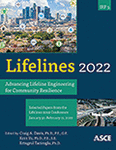Monitoring Defects in Attention Allocations of Nuclear Power Plant Operators through Operational Knowledge Representation
Publication: Lifelines 2022
ABSTRACT
During nuclear power plant (NPP) operations, operators selectively focus their attention on alarms, indicators, and control switches. Failures in allocating attention at the right time on the right parts of the workspace have been observed to cause 35% of situation assessment errors. Existing methods are inefficient in preventing such failures due to a lack of comprehensive attention allocation processes in various NPP operations. Such characterization is critical for the real-time identification of gaps in human attention for monitoring operational hazards. This paper presents formal knowledge representations for characterizing visual attention allocation processes of NPP operators. The proposed knowledge representations systematically mapped out attention drivers such as task structures, objects, and action types in operating procedures. Such a formalized representation of NPP operation knowledge can support automatic reasoning methods to identify critical objects and safety-related properties during reactor startup processes. Capturing this operational knowledge and understanding operators’ visual attention allocation principles would help establish a human-centric computing framework for ensuring the safety and efficiency of NPP operations.
Get full access to this article
View all available purchase options and get full access to this chapter.
REFERENCES
Le Blanc, K., and Oxstrand, J. (2012). Computer-Based Procedures for Field Workers in Nuclear Power Plants: Development of a Model of Procedure Usage and Identification of Requirements. (April).
Boring, R. L. (2014). “Human reliability analysis for digital human-machine interfaces: a wish list for future research.” Proc. Int. Conf. Probabilistic Safety Assessment and Management (PSAM 12).
Boring, R., Rasmussen, M., Ulrich, T., Ewing, S., and Mandelli, D. (2018). “Task and procedure level primitives for modeling human error.” Advances in Intelligent Systems and Computing, 589, 30–40.
Boring, R., Ulrich, T., Lew, R., Kovesdi, C., Rice, B., Poresky, C., Spielman, Z., and Savchenko, K. (2017). Analog, digital, or enhanced human-system interfaces? results of an operator-in-the-loop study on main control room modernization for a nuclear power plant. Idaho National Lab.(INL), Idaho Falls, ID (United States).
Cao, Y., Qu, Q., Duffy, V. G., and Ding, Y. (2019). “Attention for web directory advertisements: A top-down or bottom-up process?” International Journal of Human–Computer Interaction, Taylor & Francis, 35(1), 89–98.
Endsley, M. R. (2017). “Toward a Theory of Situation Awareness in Dynamic Systems.” Situational Awareness, Routledge, 9–42.
Guo, F., Ding, Y., Liu, W., Liu, C., and Zhang, X. (2016). “Can eye-tracking data be measured to assess product design?: Visual attention mechanism should be considered.” International Journal of Industrial Ergonomics, Elsevier, 53, 229–235.
IAEA, ed. (2019). Operating Experience with Nuclear Power Stations in Member States. Operating Experience with Nuclear Power Stations in Member States (CD-ROM), IAEA, Vienna.
Kim, Y., Park, J., Kim, S., Choi, S. Y., Jung, W., and Jang, I. (2015). “Task analysis of emergency operating procedures for generating quantitative HRA data.” Transactions of the Korean Nuclear Society.
Laumann, K., and Rasmussen, M. (2016). “Suggested improvements to the definitions of Standardized Plant Analysis of Risk-Human Reliability Analysis (SPAR-H) performance shaping factors, their levels and multipliers and the nominal tasks.” Reliability Engineering and System Safety, Elsevier, 145, 287–300.
Lee, H.-C., and Seong, P.-H. (2009). “A computational model for evaluating the effects of attention, memory, and mental models on situation assessment of nuclear power plant operators.” Reliability Engineering & System Safety, Elsevier, 94(11), 1796–1805.
Liao, H., and Hildebrandt, M. (2013). “Empirical insights on operators’ procedure following behavior in nuclear power plants.” Lecture Notes in Computer Science (including subseries Lecture Notes in Artificial Intelligence and Lecture Notes in Bioinformatics), 8019 LNAI(PART 1), 242–251.
Liu, P., and Li, Z. (2012). “Task complexity: A review and conceptualization framework.” International Journal of Industrial Ergonomics, Elsevier Ltd, 42(6), 553–568.
Meißner, M., and Oll, J. (2019). “The promise of eye-tracking methodology in organizational research: A taxonomy, review, and future avenues.” Organizational Research Methods, SAGE Publications Sage CA: Los Angeles, CA, 22(2), 590–617.
Nakayama, K., and Mackeben, M. (1989). “Sustained and transient components of focal visual attention.” Vision research, Elsevier, 29(11), 1631–1647.
Oxstrand, J., and Le Blanc, K. (2017). “Supporting the industry by developing a design guidance for computer-based procedures for field workers.” 10th International Topical Meeting on Nuclear Plant Instrumentation, Control, and Human-Machine Interface Technologies, NPIC and HMIT 2017, 2, 1282–1292.
Park, J., Kim, Y., and Jung, W. (2016). “A framework to estimate task opportunities from the operational experience of domestic nuclear power plants.” Safety Science, Elsevier Ltd, 88, 146–154.
Sasangohar, F., Thornburg, K., Cummings, M. L., and D’Agostino, A. (2010). “Mapping complexity sources in nuclear power plant domainsi.” Proceedings of the Human Factors and Ergonomics Society, 3, 2169–2173.
Wood, R. E. (1986). “Task complexity: Definition of the construct.” Organizational behavior and human decision processes, Elsevier, 37(1), 60–82.
Xing, J., and Manning, C. A. (2005). Complexity and automation displays of air traffic control: Literature review and analysis. Federal Aviation Administration Oklahoma City OK Civil Aeromedical Inst.
Information & Authors
Information
Published In
History
Published online: Nov 16, 2022
Authors
Metrics & Citations
Metrics
Citations
Download citation
If you have the appropriate software installed, you can download article citation data to the citation manager of your choice. Simply select your manager software from the list below and click Download.
